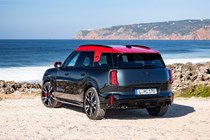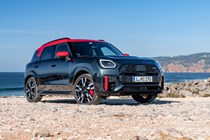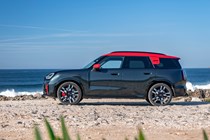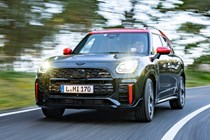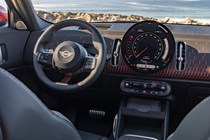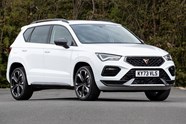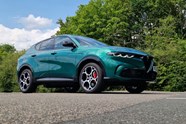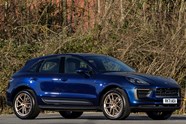MINI Countryman JCW review
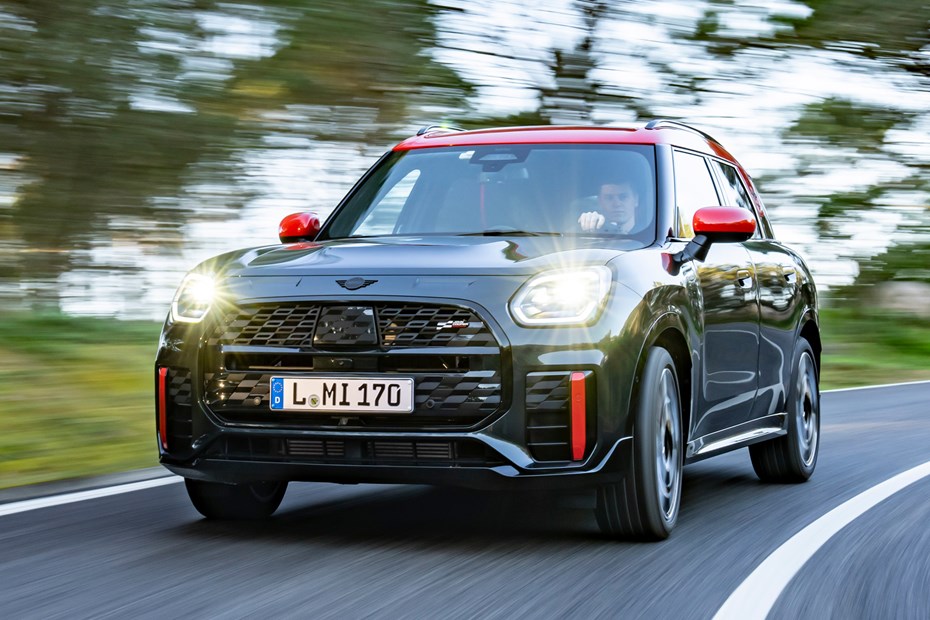
At a glance
| Price new | £41,575 - £46,775 |
|---|---|
| Used prices | £31,363 - £39,312 |
| Road tax cost | £600 |
| Insurance group | 30 |
Get an insurance quote with

|
|
| Fuel economy | 35.3 - 36.2 mpg |
| Miles per pound | 5.2 - 5.3 |
| View full specs for a specific version | |
Available fuel types
Petrol
Pros & cons
- Healthy performance
- Great fun to drive
- Very well made
- Firm suspension
- Lacking physical controls
- Boot has a high loading lip
MINI Countryman JCW rivals
Overview
This is the new MINI Countryman John Cooper Works. It’s the flagship version of the new Countryman range which, much like the previous version of the car, features a punchy turbocharged 2.0-litre petrol engine, four-wheel drive and a dogged determination to become the most entertaining family SUV on the market.
It’s undeniably fun, but we’re not going to pretend that a 300hp SUV is the most sensible purchase in these austere times. In fact, with our sensible trousers on, we’d sooner direct you towards the 1.5-litre version of the MINI Countryman and encourage you to spend the money you’d save on some extra gadgets.
However, if you’re a keen driver with a family to haul around – and you only have space for one car – the JCW makes a compelling case for itself. It was designed to square up to sporty SUVs such as the Cupra Ateca and Volkswagen T-Roc R. In our experience, it’s more than a match for the competition. Scroll down to find out why.
What’s it like inside?
Unlike anything else you can buy. The Countryman is the first MIIN – and the first car, in fact – to feature a circular OLED infotainment system. Like the previous version of the car, it’s mounted in the centre of the cabin. But instead of a rectangular display set into a circular bezel, you get a huge 24cm-diameter touchscreen.
It’s a surprisingly premium setup that really sets the Countryman apart from its rivals. The graphics are sharp, and the screen is resistant to glare from the sun – and although the unit is a little slow to switch between menus and drive modes, we expect MINI will fix that soon with some over-the-air updates. It’s brand-new tech. There are bound to be some teething problems.
MINI has really pushed the rest of the Countryman’s cabin upmarket, too. You get woven fabrics on the dashboard, plush faux leather upholstery and a snazzy ambient lighting system lurking behind the infotainment screen that projects different light patterns onto the dash depending on the drive mode you’re in. It’s different and we like it.
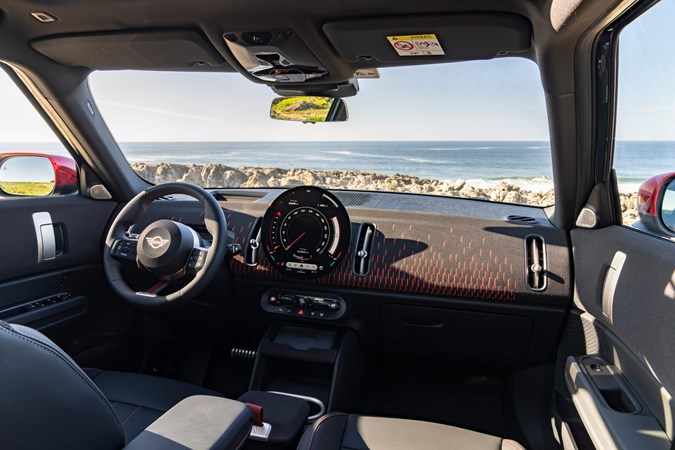
The Countryman’s drive modes are equally non-conformist. They’re called ‘MINI Experience Modes’ – and there are eight for you to cycle through. They also adjust more than is usual for drive modes, delivering more of an ambience adjustment rather than simply tweaking the calibration of the steering, dampers and throttle.
In addition, the tweaks include dedicated graphics on the display and unique artificially generated engine sounds in the cabin. MINI is so pleased with this it’s dedicated one of the few remaining physical buttons as an Experience selection switch.
We’re pleased that MINI’s proud of its workmanship, but we’d have preferred it if the firm had retained some physical air-conditioning controls instead. The touchscreen-based solution that replaces these is poorly implemented and awkward to use. MINI counters our argument by saying we could use its ‘Hey MINI’ voice control system instead – and we would, perhaps, if it worked better. Mercedes has the edge in this department.
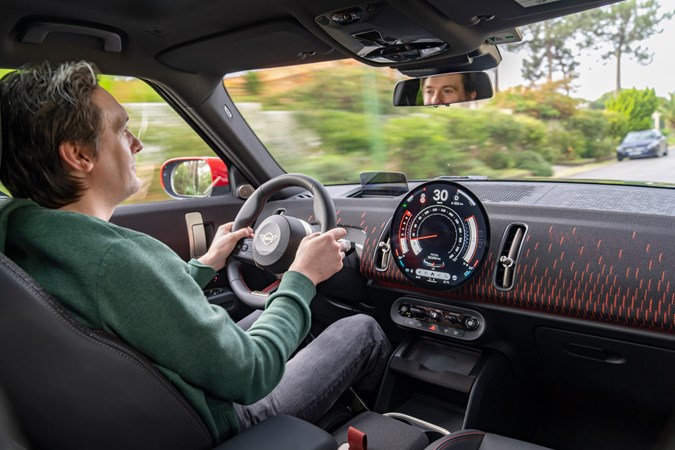
But that’s enough ranting about infotainment quirks. We’ll shift our attention to more practical matters. Like the standard Countryman, the JCW has plenty of space inside for four adults, and the rear seat can be slid backwards and forwards by 13cm if you need to balance boot space against leg room.
The boot measures a reasonable 460 litres minimum, rising to 1,530 litres with the rear seats folded. However, the rear sill is very high, making it harder to load awkward items such as push chairs.
The JCW is also peppered with racy extras, such as more heavily bolstered sports seats, a sports steering wheel, aluminium pedals and model-specific black and red upholstery for the dashboard and door cards. The changes are subtle, but they work to make the car feel a bit more purposeful.
MINI Countryman JCW engine
The Countryman JCW is only available with one powertrain. It’s a turbocharged 2.0-litre four-cylinder petrol engine that churns out 300hp and 400Nm of torque. Team that with its four-wheel drive system and you’ve got the formula for a 5.4-second 0–62mph time and the confidence to use all the available performance in the corners.
Sadly, you can’t specify the JCW (or any Countryman, for that matter) with a manual gearbox. The only option available is an eight-speed automatic. At least it comes with paddle shifters as standard, which is more than can be said for the cheapest versions of the Countryman.
What’s it like to drive?
Our early impressions of the Countryman JCW are good. It has a positive and engaging engine that’s coupled with a keen, competent transmission. It’s the faster shifting sport ‘box that’s optional on other Countryman variants. Together with the quick steering it all feels instantly rather frisky and fun. Very modern MINI, in other words, and quite the breath of fresh air if you’re used to driving a more ordinary SUV.
For the most part, this perky character remains an admirable trait the longer you drive, seldom overflowing into annoyance. The Countryman also does a reasonably good job of disguising its bulky, slightly top-heavy nature, especially in this stiffer JCW trim. But while it has a ‘Go-Kart’ Experience Mode, this is no low-slung sports car, so there is a noticeable amount of body roll if you start throwing it around more vigorously.
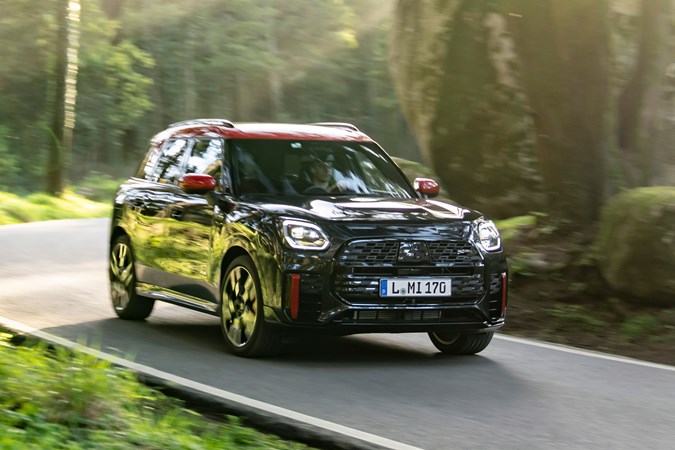
Still, with plenty of grip you’re unlikely to come unstuck on the road, and you can adapt the steering, gearbox and engine response to your preferences. It’s also easy to turn off the artificial engine noise altogether if you don’t like it, though without it the JCW does sound rather muted for a performance model.
For us, what lets it down is a lack of final finesse. The engine is a little coarse and the steering’s enthusiasm masks a slight absence of precision. Worst of all, though, is the ride quality which, despite ‘adaptive’ shock absorbers being fitted as standard, feels very firm and fidgety – something the patchwork quality of the Portuguese roads chosen for our launch event only emphasised more clearly. The adaptive process is automatic, incidentally; there’s no choice of softer or sportier settings that you can control here.
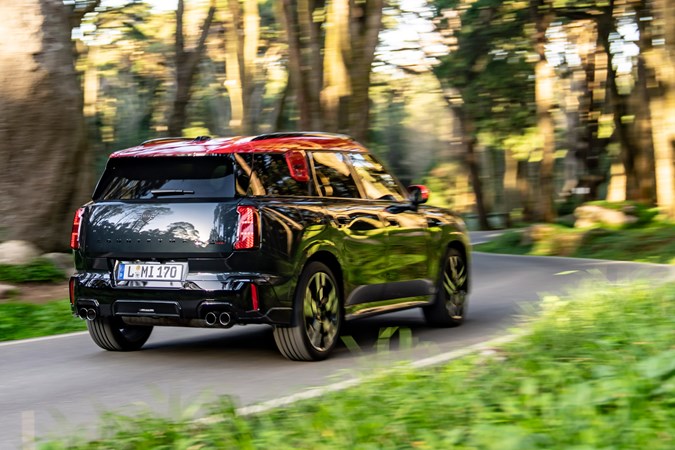
What’s more, the Countryman JCW doesn’t shrink around you the way some performance cars do, feeling every bit the biggest MINI that it is. In SUV terms, it’s among the liveliest options at the smaller end of the market but, although driving it is far from a chore and you can cover twisting roads at a very punchy pace, it never quite left us wanting to turn round and try those corners again.
What else should I know?
It’s worth mentioning the price. The Countryman JCW starts from around £40,000, which seems quite reasonable when you compare it to the £44,000 you’ll spend on a similarly powerful Cupra Ateca or the £45,000 you’ll spend on an equivalent Volkswagen T-Roc R.
MINI is also working hard to make itself appear more sustainable. So, in addition to using recycled textiles and artificial leather for the interior, the alloy wheels use 70% recycled material as well.



